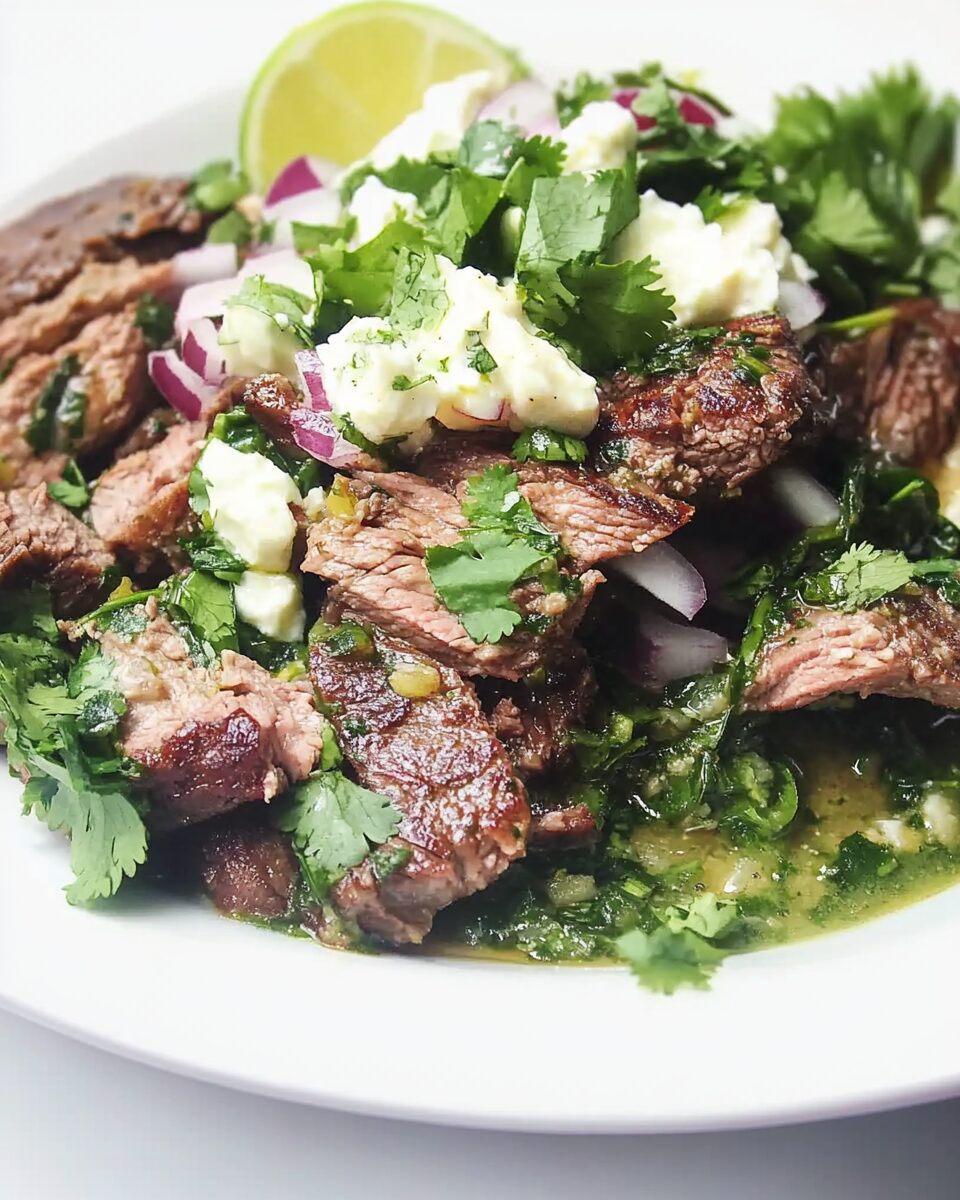Carne Asada al Cilantro is a flavorful Mexican dish that features skirt steak marinated in a cilantro-infused beer sauce and grilled to perfection. This recipe offers a delightful combination of tender beef with the fresh, aromatic essence of cilantro, making it a popular choice for gatherings and special occasions.
Full Recipe:
Ingredients
-
Marinade:
- ½ cup dark Mexican beer
- ¼ cup avocado oil
- ½ white onion, cut into large wedges
- 1 cup fresh cilantro leaves
- Salt and pepper to taste
-
Steak:
- 2 pounds beef skirt steak
-
Garnishes (optional):
- Chopped fresh cilantro
- Lime wedges
- Sliced avocado
- Warm corn or flour tortillas
Directions
-
Prepare the Marinade:
- In a blender, combine the dark Mexican beer, avocado oil, white onion wedges, fresh cilantro leaves, salt, and pepper. Blend until the mixture is smooth and well combined.
-
Marinate the Steak:
- Place the skirt steak in a large resealable plastic bag or a shallow dish. Pour the cilantro marinade over the steak, ensuring it is fully covered. Seal the bag or cover the dish and refrigerate for at least 8 hours or overnight to allow the flavors to meld.
-
Grill the Steak:
- Preheat an outdoor grill to medium-high heat and lightly oil the grate. Remove the steak from the marinade and let any excess drip off. Grill the steak for about 3 minutes per side for medium-rare, or until it reaches your desired level of doneness.
-
Rest and Serve:
- Let the grilled steak rest for a few minutes before slicing it against the grain into thin strips. Serve with your choice of garnishes and warm tortillas, if desired.
Nutrients
Per serving (approximately):
- Calories: 336
- Total Fat: 23g
- Saturated Fat: 5g
- Cholesterol: 51mg
- Sodium: 97mg
- Total Carbohydrates: 2g
- Dietary Fiber: 0g
- Sugars: 0g
- Protein: 28g
The Origins of Carne Asada
The term “carne asada” translates to “grilled meat” in Spanish, and it’s a dish that has evolved over centuries across Mexico and Latin America. Traditionally made with skirt or flank steak, the meat is seasoned or marinated, then grilled over open flames to achieve a signature charred exterior and juicy interior.
Historically, the practice of grilling meats can be traced to indigenous communities in Mesoamerica, long before European colonization. Over time, with the arrival of Spanish cattle and influences, beef became a central part of many regional diets. The grilling technique and the communal sharing of meat became popular across Mexican states such as Sonora, Nuevo León, and Baja California—regions now recognized for their carne asada culture.
While the ingredients and cooking methods may differ from region to region, the essence of carne asada remains rooted in simplicity, strong flavors, and a social experience. It’s not just a meal—it’s an event.
The Role of Cilantro in Mexican Cuisine
Cilantro is a fundamental herb in Mexican cooking, used in everything from salsas and soups to garnishes and marinades. Its bright, citrusy, slightly peppery profile enhances a wide variety of dishes and adds freshness to spicy and rich flavors.
In the context of Carne Asada al Cilantro, the herb acts as both a flavor enhancer and a balancing component. Its inclusion in the marinade works twofold: it imparts a deep herbal aroma to the beef and helps tenderize the meat along with acidic and alcoholic elements like beer or lime juice.
Cilantro also plays a psychological role in Mexican culinary tradition. Its scent and flavor evoke comfort, authenticity, and freshness, connecting diners to memories of home-cooked meals and bustling outdoor markets. Incorporating it into a classic carne asada dish adds a thoughtful twist while staying true to tradition.
Cultural and Social Importance
Carne Asada al Cilantro is often associated with gatherings. In many Mexican-American communities, weekends are reserved for “asadas,” which are backyard cookouts centered around grilled meats. These events are as much about bonding and tradition as they are about the food. Music plays, children run around, and someone is always at the grill—typically the role of a family elder or experienced cook.
The Cilantro variant of carne asada is especially appreciated during the warmer months. The refreshing quality of the herb helps balance the richness of the meat, making it perfect for pairing with fresh tortillas, avocado, lime, grilled vegetables, and crisp beverages.
Street vendors and local taquerías have also embraced Carne Asada al Cilantro, often serving it with chopped onions, cilantro, salsa verde, and lime. These tacos are quick to make, filling, and pack a punch of flavor, contributing to the dish’s rising popularity across borders.
Regional Adaptations
Although carne asada itself is universal throughout Mexico and many Latin American countries, the cilantro-infused version reflects specific regional preferences and innovations.
In Northern Mexico, especially in states like Sonora, beef is the centerpiece of local cuisine. Cooks often prefer simple salt-and-pepper seasoning, but contemporary versions, like those using cilantro or citrus-based marinades, are growing in popularity. These regions pride themselves on high-quality beef and open-flame grilling techniques.
In Southern Mexico, where tropical herbs and bolder marinades are more common, cilantro is a frequent addition to meat preparations. Here, Carne Asada al Cilantro may include more aromatics like garlic, chiles, and lime, creating layers of flavor.
Mexican-American communities have adopted the cilantro-style carne asada and elevated it by combining it with fusion flavors—using soy sauce, garlic, or even orange juice to diversify the flavor profile while still honoring the dish’s roots.
Regardless of the variation, the spirit of the dish remains constant: bold, smoky, herbaceous, and celebratory.
Health and Nutritional Aspects
Carne Asada al Cilantro is not only delicious but can also be a part of a balanced diet when prepared thoughtfully. Skirt steak, the most commonly used cut, is high in protein, iron, and zinc—essential nutrients for energy, muscle function, and immune health.
Cilantro brings its own health benefits. It is rich in antioxidants, vitamins A, C, and K, and has been traditionally used for its digestive and detoxifying properties. Including cilantro in marinades not only enhances flavor but also contributes to overall nutritional value.
When grilled, beef retains much of its nutrient density without the added fats found in frying or pan-cooking methods. For those looking to make the dish even healthier, pairing carne asada with grilled vegetables, whole-grain tortillas, and fresh salsas can transform it into a wholesome, well-rounded meal.
That said, moderation is key. Skirt steak can be high in saturated fats, and depending on how much oil or salt is used in the marinade, sodium content may also be a concern. Choosing leaner cuts, trimming visible fat, or using heart-healthy oils like avocado or olive oil can make a noticeable difference.
Versatility and Presentation
One of the standout qualities of Carne Asada al Cilantro is its versatility. The grilled meat can be served in many forms: tacos, burritos, tortas, rice bowls, salads, or even on its own with simple garnishes. This makes it adaptable for everything from casual lunches to upscale dinner presentations.
When served traditionally, it’s often sliced thin and presented on a communal platter with warm tortillas, lime wedges, and small bowls of salsa, guacamole, and beans. The aesthetic is colorful, vibrant, and welcoming—mirroring the spirit of the dish itself.
Modern food styling trends have embraced deconstructed presentations as well. Some chefs serve the steak in slices over a cilantro-lime rice bed with roasted corn, black beans, and pickled onions. Others experiment by fusing it into non-Mexican dishes, like cilantro steak sliders or carne asada-topped flatbreads.
Regardless of the form, the essence of the dish shines through: a harmonious blend of grilled beef and the bright bite of cilantro.
Emotional and Generational Connection
Carne Asada al Cilantro, like many traditional dishes, carries emotional weight. Recipes are often passed down from grandparents to parents to children, with each generation adding its own touch. Even within a single family, you’ll find debates about the “right” way to marinate or grill the meat.
This generational knowledge fosters a deep emotional connection to the dish. Preparing carne asada becomes a way to honor ancestry, preserve tradition, and celebrate the joy of shared meals. The smells and sounds associated with making this dish—blades hitting cutting boards, herbs being crushed, meat sizzling on the grill—trigger memories that transcend time and space.
For immigrants, carne asada becomes a taste of home. For locals, it’s a reminder of cultural pride. For food lovers, it’s an invitation into a culinary story that spans history and geography.
Conclusion
Carne Asada al Cilantro is more than a delightful fusion of steak and herbs—it’s a cultural emblem, a family tradition, and a celebration of simplicity done right. Its roots run deep in Mexican culinary heritage, but its appeal stretches far beyond borders. Whether enjoyed at a lively backyard barbecue, a quiet family dinner, or a bustling street food stand, this dish always delivers—offering warmth, flavor, and connection.






